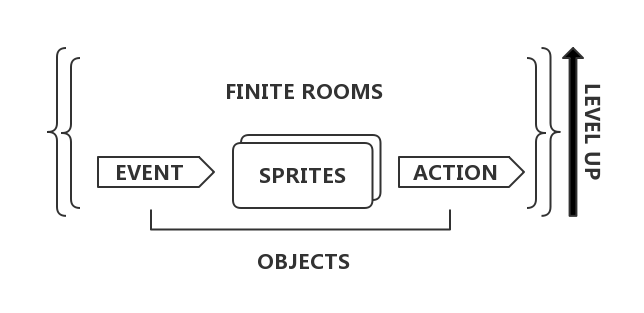Before building a game, there’s a significance to understand “What is Game”. And “Game Maker Studio 2” (abbr. GMS) is @notlsd’s favourite game engine, the game engine’s architecture is a clue to understand this meta-question of game design. Some basic knowledge of GMS is good to understand but not required.
Definition of game from “Rules of play : Game design fundamentals” by Salen & Zimmerman
A game is a system in which players engage in an artificial conflict, defined by rules, that results in a quantifiable outcome.
This is one of the most widely recgonized academic definition of game. The key words there are SYSTEM / PLAYER / ARTIFICIAL CONFLICT / RULES / QUANTIFIABLE OUTCOM. We will compare it with GMS equation later.
The GMS Equation
This is the last page of the first chapter of official guide of GameMaker Studio 2 which introduces some basic configuration of GMS engine which @notlsd call it “GMS equation”
 GMS-Equation
GMS-Equation
A Graph Definition by @notlsd
 General-Game-Architecture
General-Game-Architecture
This graph is drawn by pseudo-UML language, which defines a game.
A game is finite number of rooms under level-up conditions which includes sprites under event-action responses
Five Key Words - A Detailed Comparison Between Two Definitions
- SYSTEM - FINITY of Game Design
There are two type games, finite game and infinite game<span class=”hint–top hint–error hint–medium hint–rounded hint–bounce” aria-label=”This conecept comes from “Finite and Infinite Games” by James Carse
“>[1], but only the first type can be designed.
The following is definition in Wbester-Meriate’s dictionary of word “System”, more specificaly the 1d item
A group of devices or artificial objects or an organization forming a network especially for distributing something or serving a common purpose
What we designed is a system. If and only if we use the finity resoures the system can be built. The apperance of this finity is the limited quantity of game rooms[2].
- ARTIFICIAL CONFLICT - Series of LEVEL-UP ROOMS
What game designer have built is an artificial conflicts. More specifically, we use system to implement it, via programmer’s terminology “system is instantiation of an artificial conflict”.
The artificial conflicts consists a series of rooms in which contains it’s own envent-action response<span class=”hint–top hint–error hint–medium hint–rounded hint–bounce” aria-label=”There is more detailed discussion in “RULES” section
“>[3]. A room is a physical or virtual space where game take place. As game going on, status in different rooms have been leveled up gradually. In extremely simple condition, game only consists one room and level-up just in that room.
- PLAYER - Human or Artificial SPIRITES
According to Wikipedia):
In computer graphics, a sprite is a two-dimensional bitmap that is integrated into a larger scene
It’s a little sophisticated about the important role which sprites plays in game design. Mario is the sprite in Super Mario Bros; Pikachu is a sprites in Pokémon; Pac-man is the sprite in the Pac-man. Sprites is too important in game design that Apple names iOS game design framework “SpriteKit”.
in the view of programming perspective, players in game is sprites. These players can be controlled by Human which is player’s avatar itself , or controlled by A.I. which simply called NPC (Non-player-contolled).
- RULES - EVENT-ACTION Response
GMS is using Event-Action to represent basic game logic. As we mentioned earlier the core difference between rooms is the different event-action response they contains
The following is definition in Wbester-Meriate’s dictionary of word “Play”, more specificaly the 4c item
to perform an action during one’s turn in a game
In the system the player plays. The key concept of “play” itself is to perform some action to respond some event, In “Tetris” when bricks drops off, the player move it, In “Civilization” player respond to massive number of event from “Declaration of War” to “Change Production Queue”
- QUANTIFIABLE OUTCOM - LEVEL-UP of everything
Quantifiable outcom is the connection of everything in the game. The gaming terminology is “Level-up”. During the game process, players and enenimis are all become stronger. And if you cannot level up enough, you lose. These stepped level-up is also the source of game’s rythms.
Instances Analysis - Tetris • Civilization • Overwatch • Go • Slay Spire
| Game | Type | Room | Sprite | Event | Action | Quantitive Level Up | Finity Criterion |
|---|---|---|---|---|---|---|---|
| Tetris | Puzzle | Display box | Bricks | Dropping Bricks | Moving Bricks | Count of Elemination | No Space |
| Civilization | TBS | Geographic Map | Cities • Units | Turn-based Event | Player’s action | Culture • Food • Gold • Happiness • Production • Religion • Science • Tourism • Population etc | Any Civilization Win |
| Overwatch [4] | FPS | Artificial Map | Hero | Others’ Action | Heros’ Action | Ultimate | Time Up / Map Control |
| Slay Spire | Card | Battlefiled Box • Map | Player • Enemy | Enemy’s Action | Player’s Action | Coins • Relic • Card | 50th Floor / Death |
| Go | Board | Go board | Go stone | Opponent ‘s Stone | Play Stone | Territory | No Space |
- Update Log 2.0 - Add Everthing related about “Finity” including but not limited to words, graph and table
- Update Log 2.1 - Fix Wikipedia link problem